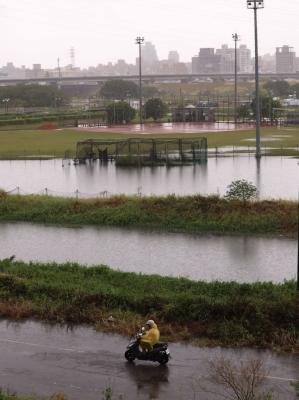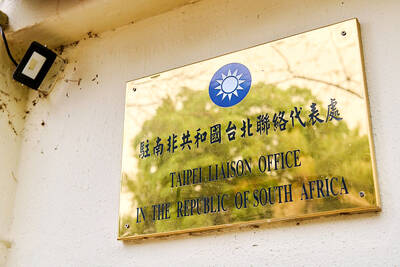The National Health Insurance Administration (NHIA) is speeding up the process of following up on about 2.3 million people with the “three highs” — high blood pressure, blood sugar and blood cholesterol levels — and might launch a “hospital version” of its family physician integrated care program as early as August, it said yesterday.
President William Lai (賴清德) has pledged to implement a five-year “888 program” for “three highs” prevention, proposed in a series of “Healthy Taiwan” forums he initiated to collect healthcare policy suggestions.
The forums were convened by Lai’s mentor, former National Cheng Kung University Hospital superintendent Chen Jyh-hong (陳志鴻).

Photo: Chiu Chih-jou, Taipei Times
In the final forum in April in Taipei, a person suggested the “888 program,” which Lai agreed to implement.
The program seeks to include at least 83 percent of people with the “three highs” into a care network, have at least 80 percent of them receive healthy lifestyle counseling and achieve a “three highs” control rate of at least 80 percent.
As only 65 percent of people with the “three highs” are included in the care network, the NHIA is considering plans to reach the 83 percent goal in five years.
About 5.34 million people had the “three highs” last year, including 3.39 million people with hypertension, 2.91 million with hyperlipidemia (high cholesterol) and 2.13 million with diabetes (high blood sugar), NHIA data showed.
NHIA Department of Medical Affairs Director Liu Lin-i (劉林義) said that treating people with the “three highs” resulted in about NT$52 billion (US$1.61 billion) in medical fees covered by the National Health Insurance (NHI) in a year.
About 3.01 million of the people with the “three highs” have been included in the agency’s family physician integrated care program or other chronic disease care programs, accounting for about 65 percent, Liu said, adding that about 700,000 of them are included in more than one program.
This year, under the upgraded family physician integrated care program, each participant would be classified into one care program, with priority given to chronic disease care programs, he said.
Removing people from multiple programs leaves about 2.3 million in the family physician integrated care program, he said.
The NHIA would ask physicians in the program to undergo more training in chronic disease care, and physicians in the chronic disease programs should enhance their preventive healthcare abilities, he said.
Regarding the 2.33 million people with the “three highs” that are not in the programs, Liu said that if they seek NHI-covered medical care at clinics and are found to meet the criteria, the family physician integrated care program would be informed to follow up on their case.
As for people who prefer seeking medical attention at hospitals, the agency is also planning to launch a “hospital version” of its family physician integrated care program at district hospitals, offering disease management and preventive healthcare services to people with chronic conditions, he said.
The government has allocated NT$500 million for district hospitals to implement a holistic community healthcare program this year, he said.
Managing the “three highs” is highly associated with lifestyle factors, so healthy lifestyle counseling — including diet, exercise, sleep quality and stress management — would be integrated into the family physician integrated care program, Liu said.
The plans for the “hospital version” of the family physician integrated care program would be further discussed tomorrow in a hospital budget meeting, and it could be launched in August at the earliest, he said.
As information on people with the “three highs” is dispersed across agencies, including the NHIA, the Centers for Disease Control and the Health Promotion Administration, a platform would be launched to integrate that data and help family physicians follow up with their patients.
Hopefully, people would one day be able to upload their health data to the platform from wearable devices, and artificial intelligence technology could help them predict their risk of developing diseases and advise them to take preventive actions earlier, he said.

Taipei, New Taipei City, Keelung and Taoyuan would issue a decision at 8pm on whether to cancel work and school tomorrow due to forecasted heavy rain, Keelung Mayor Hsieh Kuo-liang (謝國樑) said today. Hsieh told reporters that absent some pressing reason, the four northern cities would announce the decision jointly at 8pm. Keelung is expected to receive between 300mm and 490mm of rain in the period from 2pm today through 2pm tomorrow, Central Weather Administration data showed. Keelung City Government regulations stipulate that school and work can be canceled if rain totals in mountainous or low-elevation areas are forecast to exceed 350mm in

EVA Airways president Sun Chia-ming (孫嘉明) and other senior executives yesterday bowed in apology over the death of a flight attendant, saying the company has begun improving its health-reporting, review and work coordination mechanisms. “We promise to handle this matter with the utmost responsibility to ensure safer and healthier working conditions for all EVA Air employees,” Sun said. The flight attendant, a woman surnamed Sun (孫), died on Friday last week of undisclosed causes shortly after returning from a work assignment in Milan, Italy, the airline said. Chinese-language media reported that the woman fell ill working on a Taipei-to-Milan flight on Sept. 22

COUNTERMEASURE: Taiwan was to implement controls for 47 tech products bound for South Africa after the latter downgraded and renamed Taipei’s ‘de facto’ offices The Ministry of Foreign Affairs is still reviewing a new agreement proposed by the South African government last month to regulate the status of reciprocal representative offices, Minister of Foreign Affairs Lin Chia-lung (林佳龍) said yesterday. Asked about the latest developments in a year-long controversy over Taiwan’s de facto representative office in South Africa, Lin during a legislative session said that the ministry was consulting with legal experts on the proposed new agreement. While the new proposal offers Taiwan greater flexibility, the ministry does not find it acceptable, Lin said without elaborating. The ministry is still open to resuming retaliatory measures against South

1.4nm WAFERS: While TSMC is gearing up to expand its overseas production, it would also continue to invest in Taiwan, company chairman and CEO C.C. Wei said Taiwan Semiconductor Manufacturing Co (TSMC) has applied for permission to construct a new plant in the Central Taiwan Science Park (中部科學園區), which it would use for the production of new high-speed wafers, the National Science and Technology Council said yesterday. The council, which supervises three major science parks in Taiwan, confirmed that the Central Taiwan Science Park Bureau had received an application on Friday from TSMC, the world’s largest contract chipmaker, to commence work on the new A14 fab. A14 technology, a 1.4 nanometer (nm) process, is designed to drive artificial intelligence transformation by enabling faster computing and greater power